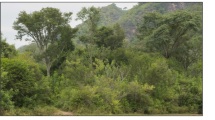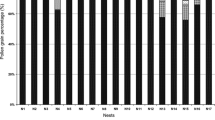Abstract
Andrena vaga and Colletes cunicularius are solitary bees distributed in Europe in regions with sandy substrate. They both nest in large aggregations and often together. Both species occur in early spring and collect pollen usually from willows (Salix). We studied the pollen loads carried into nests by females of both species during the whole nesting season in one locality (Lázně Bohdaneč, Czech Republic). Additional material was collected in 24 other localities but usually not during the whole nesting season. The results showed that Andrena vaga is monolectic on Salix but C. cunicularius collected 11 pollen types, and one type usually dominated in each pollen load. The pollen of Salix represented 60% or more, especially in the second half of the nesting season, when was collected less frequently. Although C. cunicularius is certainly polylectic, individual specialisation to one pollen type was revealed during foraging bouts. The pollen diet of C. cunicularius partly corresponded with other polylectic bees in the studied locality. The main difference was pollen of Taraxacum (Cichorioideae), which was the most represented pollen type in pollen loads of polylectic bees but nearly absent in pollen loads of C. cunicularius. Andrena vaga is probably behaviourally specialised on pollen collected on Salix only and is unable to collect pollen from flowers of other plants, contrary to C. cunicularius.




Similar content being viewed by others
References
Amiet F, Krebs A (2018) Bienen Mitteleuropas: Gattungen, Lebensweise, Beobachtung. Haupt, Bern
Beug HJ (2004) Leitfaden der Pollenbestimmung für Mitteleuropa und angrenzende Gebiete. Verlag Dr, Friedrich Pfeil, München
Biella P, Tommasi N, Akter A, Guzzetti L, Klecka J et al (2019) Correction: Foraging strategies are maintained despite workforce reduction: a multidisciplinary survey on the pollen collected by a social pollinator. PLoS ONE 14(12):e0227453. https://doi.org/10.1371/journal.pone.0227453
Bischoff I, Feltgen K, Breckner D (2003) Foraging strategy and pollen preferences of Andrena vaga (Panzer) and Colletes cunicularius (L.) (Hymenoptera: Apidae). J Hym Res 12:220–237
Bogusch P, Bláhová E, Horák J (2020) Pollen specialists are more endangered than non-specialised bees even though they collect pollen on flowers of non-endangered plants. Arthropod Plant Int 14:759–769. https://doi.org/10.1007/s11829-020-09789-y
Brosi BJ (2016) Pollinator specialization: from the individual to the community. New Phytol 210:1190–1194. https://doi.org/10.1111/nph.13951
Cane JH (2020) A brief review of monolecty in bees and benefits of a broadened definition. Apidologie. https://doi.org/10.1007/s13592-020-00785-y
Cane JH, Sipes SD (2006) Characterizing floral specialization by bees: analytical methods and a revised lexicon for oligolecty. In: Waser NM, Ollerton J (eds) Plant–pollinator interactions: from specialization to generalization. The University of Chicago Press, Chicago, pp 99–122
Černá K, Zemenová M, Macháčková L, Kolínová Z, Straka J (2013) Neighbourhood society: nesting dynamics, usurpations and social behaviour in solitary bees. PLoS ONE 8(9):e73806. https://doi.org/10.1371/journal.pone.00738069
Domínguez JA, Kumhálová J, Novák P (2017) Assessment of the relationship between spectral indices from satellite remote sensing and winter oilseed rape yield. Agron Res 15(1):55–68
Dötterl S, Vereecken NJ (2010) The chemical ecology and evolution of bee flower interactions: a review and perspectives. Can J Zool 88:668–697. https://doi.org/10.1139/Z10-031
Else GR, Edwards M (2018) Handbook of the bees of the British Isles, vols 1 and 2. Ray Society, London
Gogala A (2019) Peščinske čebele v Sloveniji (Hymenoptera: Apoidea: Andrenidae)/Andrenid bees of Slovenia (Hymenoptera: Apoidea: Andrenidae). Scopolia 96:1–189
Grimaldi D, Engel MS (2005) Evolution of the insects. Cambridge University Press, Cambridge
Hostinská L, Kuneš P, Hadrava J, Bosch J, Scaramozzino PL, Bogusch P (2021) Comparative biology of four Rhodanthidium species (Hymenoptera, Megachilidae) that nest in snail shells. J Hym Res 85:11–28. https://doi.org/10.3897/jhr.85.66544
Macek J, Straka J, Bogusch P, Dvořák L, Bezděčka P, Tyrner P (2010) Blanokřídlí České republiky I. Žahadloví. Academia, Praha
Michener CD (2007) The bees of the world, 2nd edn. Johns Hopkins University Press, Baltimore
Moore PD, Webb JA, Collingson ME (1991) Pollen analysis, 2nd edn. Blackwell, Oxford
Müller A (2018) Pollen host selection by predominantly alpine bee species of the genera Andrena, Panurginus, Dufourea, Megachile, Hoplitis and Osmia (Hymenoptera, Apoidea). Alpine Entomol 2:101–113. https://doi.org/10.3897/alpento.2.29250
Müller A, Kuhlmann M (2008) Pollen hosts of western palaearctic bees of the genus Colletes (Hymenoptera: Colletidae): the Asteraceae paradox. Biol J Linn Soc 95:719–733. https://doi.org/10.1111/j.1095-8312.2008.01113.x
Punt W, Clarke GCS (1984) The Northwest European Pollen Flora. Elsevier, Amsterdam, IV
Reille M (1992) Pollen et spores d’Europe et d’Afrique du nord. Laboratoire de Botanique Historique et Palynologie, Marseille
Robertson C (1925) Heterotrophic bees. Ecology 6:412–436. https://doi.org/10.2307/1929107
Scheuchl E, Willner W (2016) Taschenlexikon der Wildbienen Mitteleruropas. Alle Arten im Porträt. Quelle and Meyer, Wiebelsheim
TIBCO SOFTWARE INC (2017) Statistica (data analysis software system), version 13. http://statistica.io
Tommasi N, Ferrari A, Labra M, Galimberti A, Biella P (2021) Harnessing the power of metabarcoding in the ecological interpretation of plant–pollinator DNA data: strategies and consequences of filtering approaches. Diversity 13:437. https://doi.org/10.3390/d13090437
Westrich P (1989) Die Wildbienen Baden-Württembergs. Ulmer, Stuttgart
Westrich P (2018) Die Wildbienen Deutschlands. Eugen Ulmer, Stuttgart
Westrich P, Schmidt K (1987) Pollenanalyse, ein Hilfsmittel beim Studium des Sammelverhaltens von Wildbienen (Hymenoptera, Apoidea). Apidologie 18:199–214. https://doi.org/10.1051/apido:1987020
Woods TJ, Roberts SPM (2017) An assessment of historical and contemporary diet breadth in polylectic Andrena bee species. Biol Conserv 215(2017):72–80. https://doi.org/10.1016/j.biocon.2017.09.009
Zurbuchen A, Müller A (2012) Wildbienenschutz-von der Wissenschaft zur Praxis. Haupt Verlag, Bern
Zurbuchen A, Landert L, Klaiber J, Müller A, Hein S, Dorn S (2010) Maximum foraging ranges in solitary bees: only few individuals have the capability to cover long foraging distances. Biol Conserv 143:669–676. https://doi.org/10.1016/j.biocon.2009.12.003
Acknowledgements
We would like to thank Eliška Bláhová (Přelouč, Czech Republic), Petr Heneberg (Praha, Czech Republic), Peter Šima (Nové Zámky, Slovakia) and Lucie Hostinská (Hradec Králové, Czech Republic) for help with field surveys. The study was supported by the Specific Research Project of University Hradec Králové Nr. 2102/2020.
Author information
Authors and Affiliations
Contributions
PB prepared the design of the project, collected part of the data and analysed most of pollen, determined the bees, and wrote the manuscript, FA prepared the pollen samples for determination, DB, LR and SS collected part of the material, LP identified part of the pollen, SS did the analysis.
Corresponding author
Ethics declarations
Conflict of interest
The authors declare no conflict of interest.
Additional information
Publisher's Note
Springer Nature remains neutral with regard to jurisdictional claims in published maps and institutional affiliations.
Supplementary Information
Below is the link to the electronic supplementary material.
Rights and permissions
Springer Nature or its licensor holds exclusive rights to this article under a publishing agreement with the author(s) or other rightsholder(s); author self-archiving of the accepted manuscript version of this article is solely governed by the terms of such publishing agreement and applicable law.
About this article
Cite this article
Bogusch, P., Amirmohammedi, F., Benda, D. et al. Difference in pollen specialisation in spring bees Andrena vaga (Andrenidae) and Colletes cunicularius (Colletidae) during their nesting season. Arthropod-Plant Interactions 16, 459–467 (2022). https://doi.org/10.1007/s11829-022-09910-3
Received:
Accepted:
Published:
Issue Date:
DOI: https://doi.org/10.1007/s11829-022-09910-3




